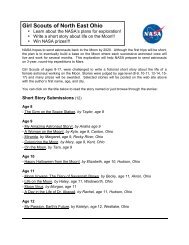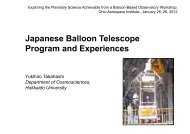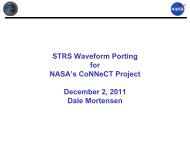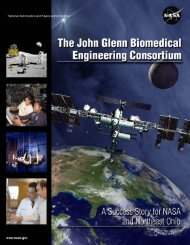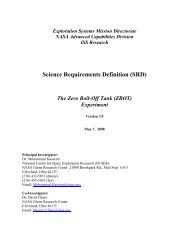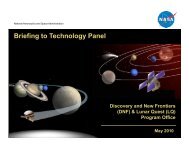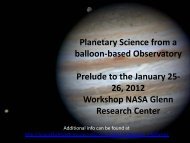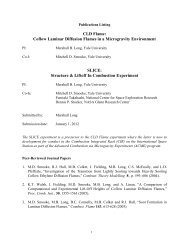Amusement Park Physics With a NASA Twist - Space Flight Systems ...
Amusement Park Physics With a NASA Twist - Space Flight Systems ...
Amusement Park Physics With a NASA Twist - Space Flight Systems ...
You also want an ePaper? Increase the reach of your titles
YUMPU automatically turns print PDFs into web optimized ePapers that Google loves.
Roller Coasters—Loops—Nonattending Students<br />
Ground Measurements<br />
The loops of a roller coaster are not circles; they are called<br />
clothoid loops. Circular loops require a higher amount of<br />
speed to keep the riders from falling out when they are<br />
upside down. Roller coasters use clothoid loops, which have<br />
a smaller radius at the top of the loop, and a longer radius<br />
where the cars enter and exit the loop (see fig. 1).<br />
Why do you think roller coasters use clothoid loops instead<br />
of circular loops<br />
Roller Coasters—Loops—Nonattending Students<br />
Ride Measurements<br />
Figure 1.<br />
1.<br />
If you rode a coaster loop at high speeds and paid close attention to whether you felt heavier,<br />
lighter, or normal in your seat, how do you think you would feel in the various locations Refer to<br />
figure 2 to assist you when completing the following table (select one per row).<br />
Location of ride Heavier Lighter Normal<br />
Going into loop (A)<br />
At top of loop (B)<br />
Going out of loop (C)<br />
2.<br />
A rider experiences a different sensation when sitting in the front<br />
than sitting in the back. First, one would ride the coaster seated<br />
in a front car. Second, he or she would ride the coaster again<br />
seated in a back car. Finally, the rider would try sitting in the<br />
middle of the coaster. In which seat location do you think the<br />
rider would experience faster speeds at the top of the loop<br />
B<br />
3.<br />
If you had a hat on your head while riding and your hat fell<br />
off as the coaster car approached the top of the loop,<br />
which way would it go, ignoring air resistance (Caution:<br />
Do not actually try this on the ride!)<br />
a) Draw the path of the hat by drawing an arrow on figure 2.<br />
b) Which of Newton’s laws applies to the hat when it leaves<br />
your head. State the complete law below.<br />
A<br />
C<br />
Figure 2.<br />
95<br />
<strong>Amusement</strong> <strong>Park</strong> <strong>Physics</strong> <strong>With</strong> a <strong>NASA</strong> <strong>Twist</strong><br />
EG–2003–03–010–GRC



